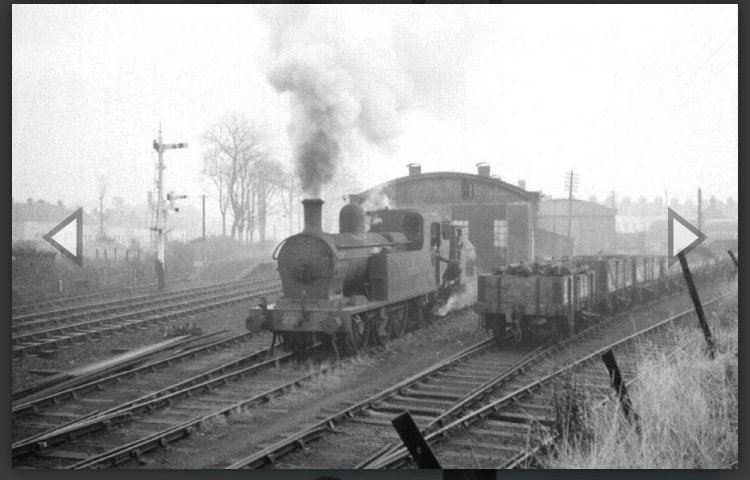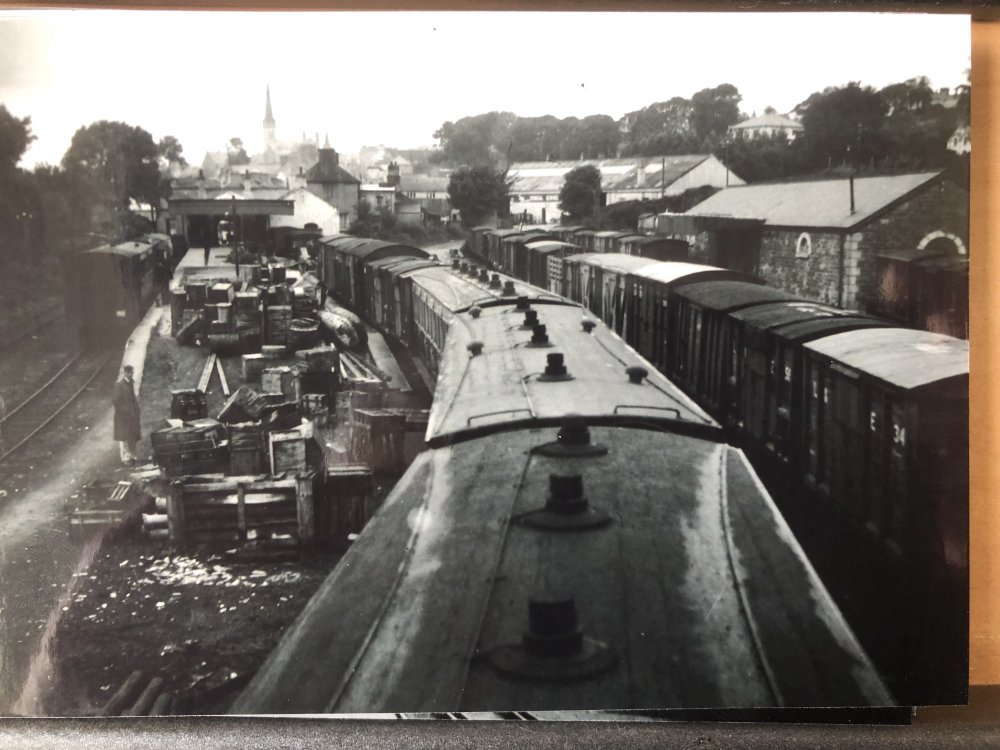
airfixfan
-
Posts
1,412 -
Joined
-
Last visited
Content Type
Profiles
Forums
Resource Library
Events
Gallery
Blogs
Store
Community Map
Posts posted by airfixfan
-
-
Railcar 1 built 1933 at York Road and not withdrawn until 1968 along with all other earlier NCC/UTA railcard
621 was cut up at Ballymena in 1983 and was often seen on the Larne line. It was converted from AEC railcar 618 about 1974 after withdrawal in 1972.
-
 2
2
-
-
This survey led to the closure of the Glenties branch which was in poor shape by 1947. Although the CDR operated the line from Victoria Road it was owned by the LMS NCC and then part of the UTA after 1948. Photos taken by Michael Bunch show that this section had the best track of any narrow gauge line in the North West
This also explains why senior was at Victoria Road. All services were steam hauled on this section until complete closure in 1955.
-
This survey Mystery indeed cabin was demolished by 1948 when Casserley took some photos on another visit. Victoria Road became a ground frame in 1946. This suggests that it must be 1947 as Andy is correct about the wagon being rebuilt about 1949. Cabin was after the end of the platform not on the platform. Has senior caught it being moved and demolished?
-
On 3/28/2020 at 4:51 PM, Galteemore said:
Spending time in the lockdown catching up on things. That photo is definitely Carrickfergus where I grew up and remember various steam engines being stored there in the old engine shed at the end of steam. Is that 27 shunting the Guinness engine about 1967?
-
Mystery indeed cabin was demolished by 1948 when Casserley took some photos on another visit. Victoria Road became a ground frame in 1946. This suggests that it must be 1947 as Andy is correct about the wagon being rebuilt about 1949. Cabin was after the end of the platform not on the platform. Has senior caught it being moved and demolished?
-
Correct that wagon was built by the LNER for LMS NCC during WW2 to replace wagons lost during the Belfast Blitz. That photo is from a book on Goods wagons in colour by Robert Hendry.
-
 1
1
-
 1
1
-
-
Checking other notes I have the section from Victoria Road to Strabane was rationalized in 1946 with work done in Derry including demolishing the signal cabin and removing the passing loop in Donemana.
-
 1
1
-
-
15 hours ago, jhb171achill said:
Time we went back to the narra gauge.
This shows just how busy the County Donegal could be.
Had the border never appeared, it’s likely we might still have Derry - Strabane at least, maybe Donegal.....
First, an absolutely chaotic Letterkenny in the early 1940s.
Secondly, a not-quite-so-busy Victoria Road (Derry). Shunting is in progress, and I understand that it was a hot sunny day (whaaat?). I think the date is either 1944 or 1947.
Interesting photo of Victoria Road station. On the left you can see track lifted recently looking towards the remains of the signal cabin. Station was rationalised about 1942 and cabin replaced by a ground frame. Cabin demolished by 1948 and with less goods traffic after WW2 would suggest 1947?
-
In the last post you refer to various Narrow Gauge projects. They are all facing financial problems due to the impact of Covid 19 crisis. You also omit the Donegal Railway Heritage Centre who have launched an appeal for financial support and help due to the cash flow impact of being forced to close their Museum.
-
 1
1
-
-
The 18 5 ton wagons in the 1942 CVR auction list are the covered wagons sold to the CDR where they became known as the red Van's. Good photos of the CVR brake Van's on pages 35 and 38 in particular in Lost railways of Co Tyrone and Co Fermanagh book from the Casserley collection.
-
In regards to local councils in 2000 Derry City Council closed the Foyle Valley Railway and Museum down to save 6,000£ per year. Since then the Council in Derry has spent tens of thousands of pounds on a series of feasibility projects which went nowhere. Now the whole Museum and its unique collection has been handed over to a local disability charity
Despite various promises the Museum remains closed but they have deliberately lost their museum accreditation status.
-
NCC 340 is at Whitehead RPSI
-
Have posted on this earlier today. They were numbered 1-6 by the CVR. 5 survived to be bought by the CDR in 1942 but saw little use so were probably not even repainted by the CDR? Suspect they all were gone by or during the cull of CDR rolling stock in 1951.
-
 1
1
-
-
The CVR had 6 brake/luggage Van's built in 1886 with 5 left in service by 1941. They were 14 feet long and appear to be the same small Van's bought at auction in 1942 by the CDR. There is a good photo of 1 of these brake Van's on page 155 of the revised Clogher Valley book. Even Michael Bunch and Sam Carse appears to have missed them also. Finally the Foyle Valley stopped running in 2000 not 2015 and the closed Museum has CDR red van 19 an ex CVR vehicle.
-
 1
1
-
-
Very interesting Patrick as photos of Ballyclare mill siding are scarce. There is a photo of this siding on page 56 of the revised edition of Pattersons classic book.
-
 1
1
-
-
29D was built new for DSER in 1922 and converted to a Kitchen car by GSR in 1938.
-
 1
1
-
 1
1
-
-
That coach was 29D and was not withdrawn until 1964.
-
The old 1980 station was demolished last week. However the clearance work has led to an issue with subsidence on the sea wall forcing NIR to close platform 1 in the new hub from lunchtime this Monday.
-
Avanti was the name of the newspaper published by Mussolini during WW1.
-
 1
1
-
-
What do the new West Coast rail operator and Mussolini have in common?
-
Suggest that the local Council or library might be interested in this superb model.
-
Very unlikely in my opinion.
-
All the ex CDR stock had been purchased by a Dentist from the USA Dr Cox who failed to raise the funds to ship it to the USA. After the retirement of Mr Curran the CDR Manager in 1965 this stock was less protected. There was also a coach and red van in covered storage at Stranrolar. All the stock that survived here ended up in the still closed Foyle Valley Railway Museum in Derry. Although railcar 18 escaped to Fintown in 2003.
-
Firstly the CDR bus in the photo ORR 333 was bought in May 1965 but not added to the CDR bus fleet list until 1966. Did some checking about Erne which was cut up in January 1968 after being repainted in Swilly green a few years earlier. Suspect the CDR did not act as it was not their property and at the same time Railcar 16 and some wagons were scrapped at Stranrolar yard which was being cleared for redevelopment. Hammond Lane from Dublin carried out the scrapping in both cases. This is what prompted the formation of the NWIRS to rescue Railcars 12 and 18 from Stranrolar where they were in secure storage along with steam loco number 6..
.png.c363cdf5c3fb7955cd92a55eb6dbbae0.png)



NIR 621
in General Chat
Posted · Edited by airfixfan
The details given are correct for the other converted AEC railcar which was renumbered 622 not 612. Thought that was 621 in the photo and ex GNR 618 then 120 originally.
Ex GNR 727 railcar trailer originally GNR 127 then 556 survived into NIR passenger service until 1982.